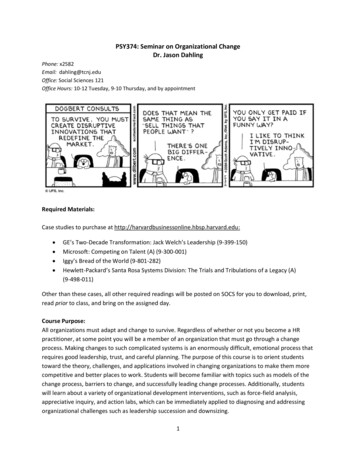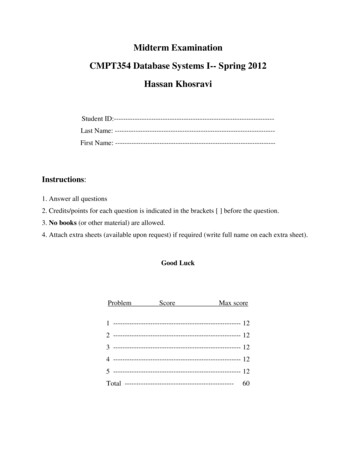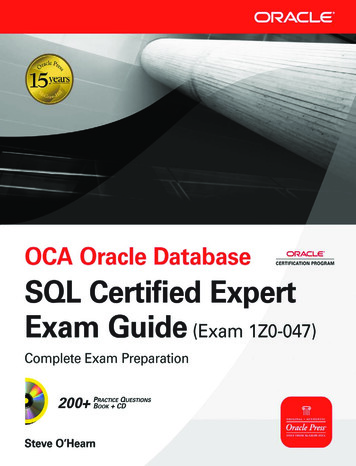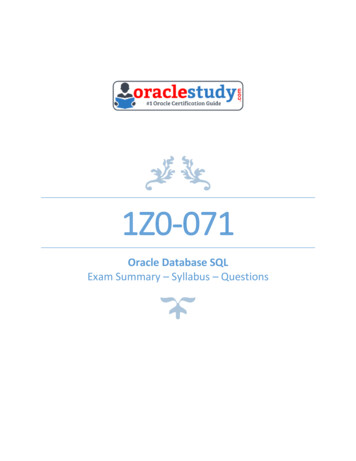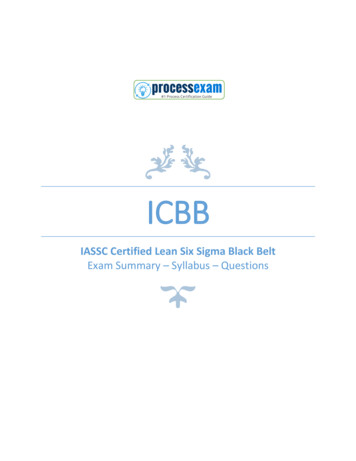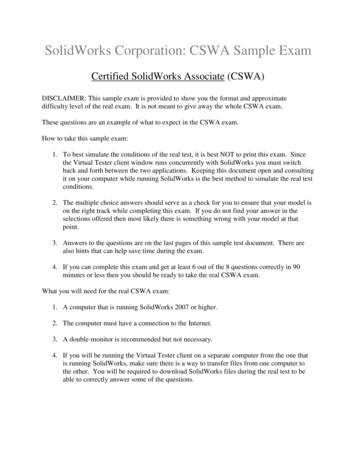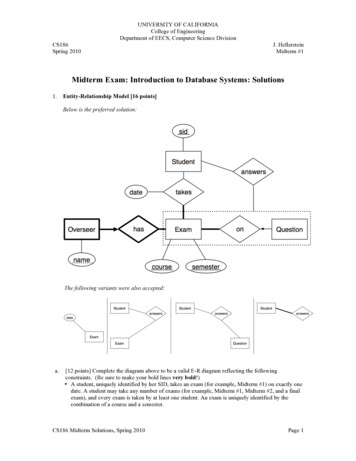
Transcription
UNIVERSITY OF CALIFORNIACollege of EngineeringDepartment of EECS, Computer Science DivisionCS186Spring 2010J. HellersteinMidterm #1Midterm Exam: Introduction to Database Systems: Solutions1.Entity-Relationship Model [16 points]Below is the preferred solution:The following variants were also accepted:a.[12 points] Complete the diagram above to be a valid E-R diagram reflecting the followingconstraints. (Be sure to make your bold lines very bold!) A student, uniquely identified by her SID, takes an exam (for example, Midterm #1) on exactly onedate. A student may take any number of exams (for example, Midterm #1, Midterm #2, and a finalexam), and every exam is taken by at least one student. An exam is uniquely identified by thecombination of a course and a semester.CS186 Midterm Solutions, Spring 2010Page 1
Every exam has at least one overseer (for example, Prof. Hellerstein, Derrick, and Bill). Anoverseer is uniquely identified by an exam and the overseer's name. There is at least one question on every exam, and a question appears on at most one exam. Aquestion on an exam may be answered by any number of students, and a student may answermultiple questions on an exam.Points for question 1(a) were assigned according to the following rubric: 1“name” is underlined with a dotted line and connected to “Overseer” with a regular line. 1“Overseer” and “has” are bolded, and there is a bold arrow from “Overseer” to “has” 1“Exam” and “has” are connected with a bold line 1“Exam” and “takes” are connected with a bold line 1“Exam” and “on” are connected with a bold line 1“course” and “semester” are underlined with solid lines. “Exam” and “course” areconnected with a solid line. “Exam” and “course” are connected with a solid line. 1“Question” is connected to “on” with a regular arrow 1“date” is connected to “takes” (preferred) or to “Exam” with a regular line, and is notunderlined. 1“takes” is connected to “Student” with a regular line 1“sid” is underlined and connected to “Student” with a regular line 1“Student” is connected to “answers” with either a regular or a bold line 1“answers” is either connected to “Exam”, “Question”, or to an aggregate surrounding“Exam”, “on”, and “Question”, with a regular line.-1Extraneous markings were included, such as bolding a relation other than Overseer orunderlining a relation. [2 points] Consider the following E-R diagram, which is a fragment of a simple board game schemathat captures the legal moves available in each position on a board:We want to translate “Moves” into an SQL table and maintain the constraints in the ER diagram.Correctly complete the SQL statement below (note that “--" begins a comment in SQL):CREATE TABLE Moves(direction CHAR(2), -- one of N/S/E/W/NE/NW/SE/SWLeftRight CHAR, -- one of A-PUpDown INTEGER, -- one of 1-16PRIMARY KEY(Direction, LeftRight, UpDown),(1 pt)FOREIGN KEY (LeftRight, UpDown) REFERENCES Position (1/2 pt)ON DELETE CASCADE(1/2 pt));CS186 Midterm Solutions, Spring 2010Page 2
[2 points] The figure with ovals and circles below illustrates a relationship set between two entity sets.Each circle is an entity or relationship, and the edges connect them. The ER diagram right below thatfigure needs to be completed with constraints that are consistent with the edges in the diagram. Foreach of the following, circle the correct answer: (1/2 pt each) A bold edge between E1 and R is :A) neededB) optionalC) disallowed An arrowhead between E1 and R is:A) neededB) optionalC) disallowed A bold edge between E2 and R is:A) neededB) optionalC) disallowed An arrowhead between E2 and R is:A) neededB) optionalC) disallowedCS186 Midterm Solutions, Spring 2010Page 3
2.Query Processing [15 points]Consider the following relations:CREATE TABLE Employee (SSN integer, DepartmentID integer,PRIMARY KEY (SSN),FOREIGN KEY (DepartmentID) REFERENCES Department);(100,000 tuples; 1100 pages)CREATE TABLE Department (DepartmentID integer, Name char(40),PRIMARY KEY (DepartmentID));(1000 tuples; 50 pages)And consider the following join query:SELECT SSN, DepartmentID, NameFROM Employee, DepartmentWHERE Employee.DepartmentID Department.DepartmentIDAssume there are no indexes available, and both relations are in arbitrary order on disk. Assume thatwe use the refinement for sort-merge join that joins during the final merge phase. However, assumethat our implementation of hash join is simple: it cannot perform recursive partitioning, and does notperform hybrid hash join. The optimizer will not choose hash join if it would require recursivepartitioning.For each of these questions, 2 points was given for the correct algorithm and 3 points for the correctcost. If the algorithm was incorrect but the cost was correct for the given algorithm, 1 point was given.One point was deducted if the name of an algorithm wasn’t quite right. If the cost calculationcontained a few minor errors, or was incomplete, 1 or 2 points were deducted. [5 points] Assume you have B 3 memory buffers, enough to hold 3 disk pages in memory atonce. (Remember that one buffer must be used to buffer the output of a join). What is the bestjoin algorithm to compute the result of this query? What is its cost, as measured in the numberof I/Os (i.e., pages requested. Do not include the cost of writing the final output. You mayignore buffer pool effects in this question.) Sort-Merge Join: Supposing number of passes to sort Employee is PE and number ofpasses to sort Department is PD, cost is (2PE - 1) Employee (2PD – 1) Department with the refinement and (2PE 1) Employee (2PD 1) Department without the refinement. Either answer was accepted,since the problem asked you to use the refinement but it’s not technicallypossible in this case (not enough buffers).In this case PE 10 (at the beginning of each pass there are 1100, 367, 184,92, 46, 23, 12, 6, 3, 2 sorted runs). Similarly PD 6 (runs are 50, 17, 9, 5, 3,2). Credit was given if you were off by one in either case. Consequently thefollowing are all valid answers for cost in this problem:19150, 19250, 19350, 21350, 21450, 21550, 21650, 23550, 23650, 23750,23850, 25850, 25950, 26050(The actual answer is 23750)Hash Join: Not applicable, since B2 9 50 min( Employee , Department ). Couldonly be done with recursive partitioning, which was excluded.Doubly-nested loop join: cost is NumTuples(Department)* Employee Department (1000)(1100) 50 1100050 23750Page-oriented doubly-nested loop join: cost is Department * Employee Department (50)(1100) 50 55050 23750Block nested loops join: B – 2 1, so same as page-oriented doubly-nested loop join.CS186 Midterm Solutions, Spring 2010Page 4
[5 points] Suppose that instead of having 3 memory buffers we have B 11 memory buffers. Whatis the best join algorithm now, and what is its cost (again, without writing final output orconsidering buffer hits)? Hash Join: Since B2 121 50 min( Employee , Department ), we can use hash join inthis problem. We partition Employee into 10 partitions, then partitionDepartment into 10 partitions (average size 5), then load each Departmentpartition into memory while streaming through the corresponding largerEmployee partition. Since there is no recursive partitioning, total cost is3( Department Employee ) 3(1100 50) 3450. Sort-Merge Join: Supposing number of passes to sort Employee is PE and number ofpasses to sort Department is PD, cost is (2PE - 1) Employee (2PD – 1) Department with the refinement and (2PE 1) Employee (2PD 1) Department without the refinement. Either answer was accepted,since the problem asked you to use the refinement but it’s not technicallypossible in this case (not enough buffers). Another option was to use therefinement on the Department relation but not the Employee relation, for acost of (2PE 1) Employee (2PD - 1) Department .In this case PE 3 (at the beginning of each pass there are 1100, 100, 10sorted runs) and PD 2 (runs are 50, 5). The following are valid answers forcost: 5650, 7850, 7950. These are more than the cost of hash join, but werestill accepted because that solution was not known at the time of grading. Block nested loops join: Cost is (ceiling( Department /(B-2)) * Employee ) Department (6)(1100) 50 6650. This is faster than Sort-Merge Join(since the refinement giving 5650 cost can’t actually be used), but slower thanHash Join. Doubly-nested loop join, page-oriented doubly-nested loop join: costs same as in firstpart above, both far more than the above options. [5 points] Suppose we raise the number of memory buffers to B 52, and increase the size of theDepartments relation to 500 pages. What is the best join algorithm now, and what is its cost (nowriting final output, ignoring buffer hits)? Hash Join: Since B2 2704 500 min( Employee , Department ), we can use hash joinin this problem. Since there is no recursive partitioning, total cost is3( Department Employee ) 3(1100 500) 4800.Sort-Merge Join: Number of buffers is now large enough to sort each relation in twopasses, with enough room to do the refinement for both relations (1100/52 500/52 32 52). So cost is 3(1100 500) 4800, same as Hash Join.Doubly-nested loop join: cost is NumTuples(Department)* Employee Department orabout (10000)(1100) 500 11000500 4800Page-oriented doubly-nested loop join: cost is Department * Employee Department (500)(1100) 500 550500 4800Block nested loops join: Cost is (ceiling( Department /(B-2)) * Employee ) Department (500/(52-2))(1100) 500 11500 4800.CS186 Midterm Solutions, Spring 2010Page 5
3.Files and Buffer Management [10 points] [3 points] Consider a buffer pool of 3 frames, and a heap file of 100 sequential pages withpageIDs from 1 to 100. Assume we scan the heap file twice from start to finish. Starting withan empty buffer pool, using an MRU replacement strategy, which pages will be in the bufferpool after the second scan?1, 99, 100. Initially the pool fills with 1, 2, 3. Then the 3 position is overwritten until the endof the first pass, at which point it is 1, 2, 100. During the second pass, 1 and 2 are hits, thenthe 2 position is overwritten until 99 is reached. Finally 100 is a hit. [1 point] What is the hit rate (#hits/#requests) in the scenario of part (a)?3/200 or 1.5%. Only 1, 2, and 100 are hit, once each. [3 points] To save a random I/O, your friend suggests that we scan the file once from pageID1 to pageID 100, and then switch into reverse and scan from pageID 100 back down to 1.Again starting with an empty buffer pool and using MRU, what pages will be in memory atthe end of this scan?1, 2, 3. Initially the pool fills with 1, 2, 3. Then the 3 position is overwritten until the end ofthe first pass, at which point it is 1, 2, 100. During the second pass, 100 is a hit, then the 100position is overwritten until 3 is reached. Finally 1 and 2 are hits. [1 point] What is the hit rate (#hits/#requests) in the scenario of part (c)?3/200 or 1.5%. Only 100, 2, and 1 are hit, one each. [1 point] Consider a sorted file organization as we studied in class, with N tightly packedpages of records. Write an expression for expected (average case) number of I/O requests foran equality lookup in the file.log2 N. This can be achieved with binary search on the pages, followed by searching the pagecontaining the record in memory. [1 point] Again using MRU and starting with an empty buffer pool, what is the expected hitrate in the buffer pool for the scenario of part (e)?0%. No page is read more than once.CS186 Midterm Solutions, Spring 2010Page 6
4.B -Trees [15 points] [5 points] The B -tree drawn below has order 3 (i.e. max 6 pointers per internal node), and containsa number of errors. Circle the errors and draw a new correct B -tree over the same data entries (theentries in the leaves).There are two errors above and one non-error: (1 pt) The internal node containing only “4” is underfull. It has 2 pointers, less than theminimum of 3 (which is half the maximum of 6).(1 pt) The value “7” is in the left subtree of the root, but should be in the right subtree,since the key in the root node is 6 and 7 6.(1 pt) The internal node containing “11 15” is not underfull, because it contains 3pointers to child nodes, which is exactly half the maximum (6 pointers).Additionally, the presence of the key “11” which is not present in any leaf isnot an error (internal nodes may contain values which were once present inleaves but have since been deleted). This point was deducted if this internalnode was marked erroneous.Additionally, the root node is not underfull because the root node is specially permitted to be lessthan half full. Following is a correct new B -tree over the same data entries:This is the unique correct B -tree with the exact same leaf nodes. It was also valid to compact thedata values into a smaller number of leaf nodes, if the values in the root are adjusted accordingly. Itis not possible to use more than one internal node.CS186 Midterm Solutions, Spring 2010Page 7
[5 points] Consider the B -tree with order 2 (max 4 pointers per node) drawn below. Draw whatthe tree would look like after inserting 9*When 9 is inserted, it goes into the node containing “5 6 7 8”. However, this node is now overfull andmust be split into two nodes “5 6 7” and “8 9”. The value 7 is added to the parent internal node,which is now in turn overfull, so it is split into “5 7” and “10 12”. Finally a new root node is createdand “7” is moved to the root node.Alternatively, we can make all our splits with the smaller side on the left. In this case, the overfull leafis split as “5 6” and “7 8 9”, 8 is added to the parent node, and “10” is moved to the new root nodeinstead of the new value. Both trees are shown below.Points were given as follows: 1Result is valid B -tree. No node is underfull and no keys in internal nodes are incorrect. 1Leaf split was performed correctly. 1Internal node split and creation of new root node was performed correctly. 1Always split with either the smaller side on the left or the smaller side on the right; donot mix both strategies.CS186 Midterm Solutions, Spring 2010Page 8
[5 points] Assume we have a B tree with room for 30 bytes of data on each internal page: sohalf-full at 15 bytes. Assume that a pageID (a “pointer” in the tree) takes up 4 bytes, and acharacter takes 1 byte. Consider the 1st B -tree below. Draw a correct B -tree for this data thatuses the leaf level provided in the 2nd picture below, but employs prefix key compression above.New root node uses a total of 4(4) 2 3 2 23 30 bytes (assuming string prefixes are nullterminated or length-prefixed with a single byte), so it all fits in one node.Points were given as follows: 1Result is valid B -tree. No node is underfull and no keys in internal nodes are incorrect. 1Some keys were compressed (shortened) by at least one character 1All keys in internal nodes were compressed (shortened) as short as possible 2Final tree has only two levels, root and leavesCS186 Midterm Solutions, Spring 2010Page 9
CS186 Midterm Solutions, Spring 2010 Page 1 UNIVERSITY OF CALIFORNIA College of Engineering Department of EECS, Computer Science Division CS186 J. Hellerstein Spring 2010 Midterm #1 Midterm Exam: Introduction to Database Systems: Solutions 1. Entity-Relati


